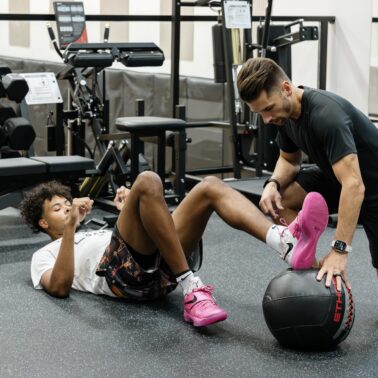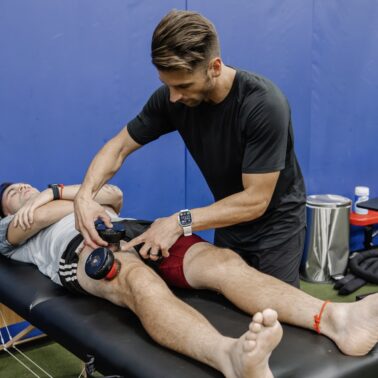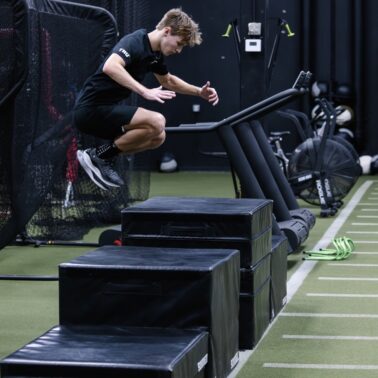“Understanding the architectural gear ratio can improve exercise selection and ultimately enhance a physical therapist or coach’s ability to rehab muscle injuries.”
Adam Loiacono
What You Will Learn
- What is the architectural gear ratio.
- Why the architectural gear ratio is important to understand for physical therapists during sports rehab.
- How to improve your exercise selection by implementing principles from the muscle’s architectural gear ratio.
The human body is an intricate machine, with its muscles serving as the engines that power movement. Among the fascinating aspects of muscle physiology is the concept of the Architectural Gear Ratio (AGR), a critical factor in understanding how muscles work. In this comprehensive blog post, we will explore what AGR is, look into relevant anatomy, examine specific muscles, and highlight its importance in various contexts such as muscle injuries, sports, rehabilitation, and performance training.
1. Introduction to Architectural Gear Ratio
The Architectural Gear Ratio (AGR) in muscles is similar to the gear system in a bicycle. It is the ratio of the velocity of muscle fiber shortening to the velocity of the muscle-tendon unit shortening. This ratio is determined by the muscle’s architecture, particularly the arrangement of muscle fibers and their angle, known as the pennation angle.
Anatomy and Muscle Fiber Arrangement
Muscles are made of fibers arranged in specific patterns: parallel or pennate. In parallel muscles, fibers run along the length of the muscle, as seen in the semitendinosus or semimembranosis. In contrast, pennate muscles have fibers oriented at an angle to the line of force, like the quadriceps.
Pennation Angle and Its Significance
The pennation angle is pivotal in determining a muscle’s AGR. A larger pennation angle allows more fibers to be packed into a muscle. Pennated muscles have a high AGR and thus bias them towards force. Muscles like the pectoralis major or the quadriceps have large pennation angles that allow for higher volumes of muscle fibers, higher AGR, and thus higher force capabilities.
Interestingly though, a singular muscle can vary it’s AGR. Let’s take the hamstring muscles for example. The proximal hamstrings have a lower gear ratio suggesting the proximal attachment has a velocity bias. The distal hamstrings have a higher gear ratio due to the fiber orientation similar to that of a pennate muscle.

(Left) The quadriceps muscle of the thigh shows the multiple fiber orientations that create this pennated muscle. (Right) The semitendinosus muscle shows muscle fibers in parallel. Each of these fiber orientations impacts the AGR.
2. Muscles and the force-velocity curve
The force-velocity curve is most often discussed when implementing performance training programs. On the contrary, it is often overlooked when programming part-task and isolated muscle training during early rehab. AGR plays a crucial role in dictating a muscle’s ability to produce force and the speed of its contraction. Let’s examine two specific muscles to further highlight the how structure can dictate function:
- Semitendinosus: overall, this hamstring muscle has a lower AGR due to its parallel fiber arrangement, facilitating rapid movement but with less force. This muscle would be considered velocity dominant.
- Quadriceps: The quadriceps muscle, with a higher AGR due to its pennate structure, allows for more forceful but slower contractions. This muscle is considered force dominant.
Force vs. Speed Trade-off
AGR determines the trade-off between force production and contraction speed in a muscle. High AGR muscles (with high pennation angles) are more forceful but slower, while low AGR muscles are faster but produce less force.
Understanding this tradeoff can help coaches and therapists navigate exercise selection within the rehab or training process. For example, improving quadriceps quality after a muscle strain should be focused on ‘strength’ while improving hamstring quality after a muscle strain should be focused on ‘speed.’

The force-velocity curve demonstrates the tradeoff and balance between speed and force.
3. Importance of AGR in Muscle Injuries
The AGR plays a crucial role in understanding muscle injuries. When a muscle is injured, its architectural properties, including the pennation angle, can be altered, leading to changes in its AGR. This alteration impacts the muscle’s ability to generate force and its contraction speed, which are vital for efficient movement and stability.
For effective rehabilitation, it’s essential to understand the injured muscle’s AGR. A change in AGR due to injury can lead to an imbalance in force production and movement efficiency, potentially causing compensatory injuries or prolonged recovery. Rehabilitation exercises tailored to restore the muscle’s optimal AGR can help in regaining its original function, ensuring a more effective and targeted recovery process. This approach aids in restoring the muscle’s strength, flexibility, and overall performance, crucial for a complete recovery.
Rehabilitation Strategies
Let’s keep things simple and use a common KPI that is used within knee rehab – hamstring to quadriceps ratio for strength. Literature suggests the hamstring to quadriceps ratio is 65%, meaning the hamstring strength is 65% of that of the quadriceps. If we consider the velocity dominance of the hamstrings and the force dominance of the quadriceps based on AGR, then this makes complete sense. The structure of these different muscles biases the quadriceps to always be stronger than the hamstrings.
We should never see a hamstring to quadriceps ratio 100%. If we do, then there are potentially two problems. One is that the quadriceps is so weak that the higher hamstring to quadriceps ratio is misrepresented. The second problem could be that we have inappropriately trained the hamstrings to be force-dominant when structure suggests they need to be velocity dominant.
4. AGR in Performance
AGR is a key factor in sports, determining which muscles are best suited for specific activities. There is a reason why ‘force-dominant’ athletes have massive quads and glutes. These muscles are large, pennated muscles with high AGR that bias the athlete to be force dominant. On the contrary, there are reasons why ‘velocity-dominant’ or ‘fascial-driven’ athletes may have less muscle mass overall because they do not have hypertrophy of the large pennated muscles.
Understanding AGR helps in designing training regimens for athletes to enhance their performance. Athletes can benefit from exercises that specifically target muscles with the desired AGR for their sport. For example, a weightlifter would focus on muscles with a higher AGR for increased force production while a sprinter may focuse on muscles with lower AGR to increase speed production.
- Traditional Resistance Training: Ideal for muscles with higher AGR, increasing their ability to produce force.
- Plyometrics: Beneficial for training muscles with lower AGR, improving speed and agility.
Research, Science, & References
- Azizi E, Roberts TJ, Marsh RL. Spring in the step: the origins of elastic energy storage in tendons. Nature Reviews Rheumatology. 2010;6(7):419-426. doi:10.1038/nrrheum.2010.96.
- Azizi E, Roberts TJ. Muscle performance during frog jumping: influence of elasticity on muscle operating lengths. Proceedings of the Royal Society B: Biological Sciences. 2010;277(1687):1523-1530. doi:10.1098/rspb.2009.2049.
- Azizi E, Brainerd EL, Roberts TJ. Variable gearing in pennate muscles. PNAS. 2008 Feb 5;105(5):1745-50. doi:10.1073/pnas.0709212105.
- Azizi E, Brainerd EL. Muscle fiber angle, segment bulging and architectural gear ratio in segmented musculature. Journal of Experimental Biology. 2002;205(Pt 3):431-442.
- Azizi E, Roberts TJ. Biaxial strain and variable stiffness in aponeuroses. Journal of Physiology. 2009;587(Pt 17):4309-4318. doi:10.1113/jphysiol.2009.175182.
These articles provide a comprehensive view of the architectural gear ratio in muscles, covering various aspects such as the influence of elasticity on muscle operating lengths, the origins of elastic energy storage in tendons, and the variable gearing in pennate muscles. They offer valuable insights into the biomechanical and physiological properties of muscles, particularly in the context of muscle performance and efficiency.
Conclusion
The Architectural Gear Ratio in muscles is a pivotal concept that bridges the gap between muscle anatomy and function. It has profound implications in various fields, from understanding muscle injuries to enhancing sports performance and rehabilitation strategies. By tailoring exercises and training programs to the specific AGR of muscles, we can optimize muscle function and performance, and aid in more effective recovery from injuries.
In conclusion, whether you are an athlete, a fitness enthusiast, a rehabilitation professional, or simply someone fascinated by human anatomy, understanding the AGR of muscles provides invaluable insights into the workings of our muscular system. It underscores the importance of a tailored approach in sports training, injury recovery, and overall physical wellness.



